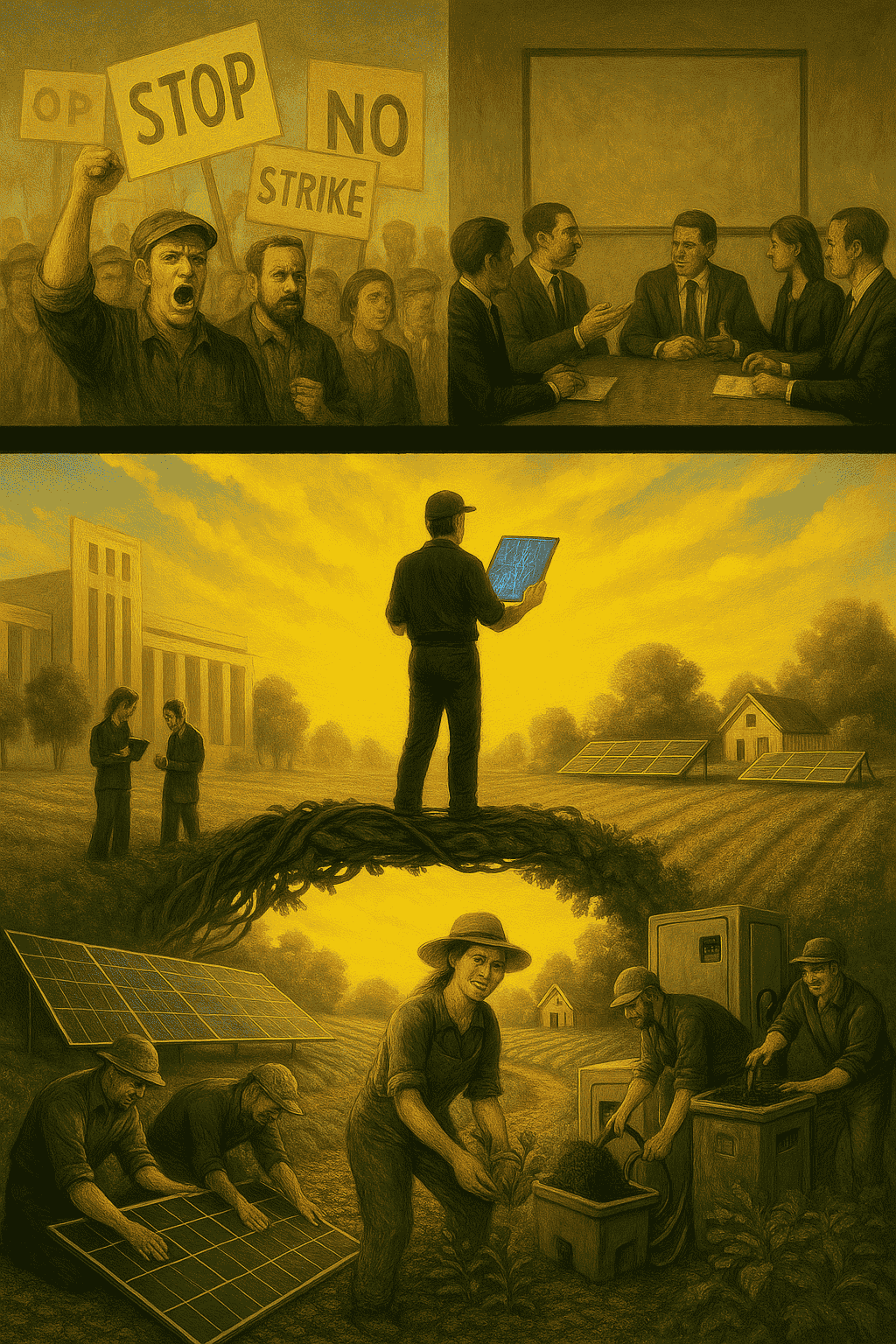When David Suzuki says “it’s too late,” he’s not revealing weakness – he’s exposing the most dangerous vulnerability in our climate response: the complete disconnect between those measuring the crisis and those solving it.
I’ve written before about compromised data pipelines and implementation crises in climate action. But watching respected voices amplify defeatist messaging while breakthrough solutions go unrecognized has crystallized something crucial: our climate leaders aren’t giving up because the situation is hopeless. They’re expressing despair because their information systems are fundamentally broken.
The Information Isolation Problem
Picture this: In 30+ countries worldwide, HumiSoil technology is transforming agriculture and waste management simultaneously. This innovation processes virtually any organic material in a fraction of the time traditional composting requires, produces no significant odor, eliminates fire risk, and creates soil amendments that hold up to 30% more water while sequestering carbon for decades.
Yet when I mention this to climate advocates in America, I’m met with blank stares. Not skepticism about the technology – they’ve simply never heard of it. Meanwhile, established composting industries actively resist implementation because they see innovation as competition rather than progress.
This pattern repeats across domains. Regenerative practitioners are succeeding project by project, upstream interventions are bypassing institutional gridlock, and coalition strategies are turning former opponents into allies. But none of this reaches the scientists, advocates, and leaders shaping public perception about what’s possible.
The result? Even our most trusted voices operate on incomplete information, measuring global systems while remaining blind to local breakthroughs.
The Asymmetric Warfare Lesson

When climate communicators quote military strategy about demoralization while advocating surrender, it reveals a fundamental misunderstanding of how asymmetric conflicts actually work.
Ukraine isn’t defeating Russia by matching their military spending dollar-for-dollar. They’re winning through strategic innovation: cheap drones destroying expensive infrastructure, targeting supply lines rather than armies, and building international coalitions that isolate their opponent.
Effective climate action follows identical principles. For decades, we’ve tried to out-spend fossil fuel companies in marketing budgets – a battle we were always destined to lose. Meanwhile, the real victory comes through building alternatives that make extractive systems irrelevant.
My background in military psychological operations in the 90s taught me that effective influence campaigns focus on capacity building, not propaganda wars. You don’t win hearts and minds through louder messaging – you win by demonstrating better alternatives and creating the infrastructure for people to choose differently.
What the Data Pipeline Misses
The information reaching climate leaders has been systematically filtered to exclude breakthrough successes. Consider why:
Institutional Capture: Organizations built to manage problems develop vested interests in those problems persisting. A food bank president once told me directly: “We can’t afford to let our donors know that other options besides food banks exist.” This wasn’t unique – it’s a pattern I’ve encountered across states and sectors.
Academic Gatekeeping: Peer review systems filter out practical innovations that don’t fit established theoretical frameworks. Breakthrough technologies like HumiSoil don’t get published in climate journals because they emerge from agricultural and waste management domains.
Media Selection Bias: Coverage focuses on dramatic failures and protests rather than quiet implementation successes. Building working alternatives doesn’t generate clicks like conflict does.
Conference Circuit Echo Chambers: The same voices reinforcing the same narratives at the same events, while practitioners implementing solutions work in different networks entirely.
Like the absent-minded scholars in Gulliver’s Travels who needed servants called “flappers” to literally strike their ears to make them notice reality, our climate leaders need better information systems to see what’s actually working.
The Implementation Reality
From my perspective building food system solutions, waste-to-value technologies, and regenerative coalitions, the landscape looks entirely different than the one described in mainstream climate discourse.
I’ve watched farmers eager to adopt soil-building technologies once they bypass gatekeeping institutions. I’ve seen corporations desperate for waste management solutions that create value rather than disposal costs. I’ve built alliances between unlikely partners – breweries and fire mitigation groups, urban waste generators and rural regeneration efforts.
The resistance isn’t coming from technological limitations or economic barriers. It’s coming from institutional systems designed to protect existing approaches rather than enable better ones.
When breakthrough solutions exist but can’t reach decision-makers, when successful models can’t access replication support, when coalition opportunities are invisible to potential partners – that’s not a climate crisis. That’s an information architecture crisis.
Bridge-Building Solutions
The solution isn’t to abandon global climate measurement or dismiss the urgency of systemic change. It’s to build information bridges between the communities measuring problems and those implementing solutions.
Connect Scientific Assessment with Practical Implementation: Climate researchers need direct relationships with regenerative practitioners, not just abstract data about emissions.
Create Systematic Success Documentation: Build platforms that make breakthrough implementations visible to systems thinkers and decision-makers.
Develop Cross-Scale Feedback Loops: Ensure insights from local success stories inform regional and global strategy development.
Build Implementation-Focused Coalitions: Connect communities working on similar solutions across traditional institutional divides.
The Real Fight
We’re not losing the climate fight. We’re finally learning how to win it.
The renewable energy statistics that even defeatist posts acknowledge – 96% of new U.S. power capacity being fossil-free, dramatic cost reductions in solar installation, falling emissions across multiple regions – these aren’t accidents. They’re the results of implementation strategies that built alternatives rather than just opposing problems.
But until we fix the information gap between those measuring the crisis and those solving it, we’ll continue seeing respected voices express despair while breakthrough solutions remain invisible.
The most revolutionary act isn’t protesting the system – it’s building its replacement in spaces the system can’t see. And then making sure our climate leaders can see it too.
David Suzuki deserves better information. So do we all.
Shannon Dobbs is founder of Fellowship of Living Systems, developing coalition strategies for community-controlled climate resilience. His work focuses on upstream interventions that create cascading benefits across food, waste, and agricultural systems. Learn more at https://LivingSys.org

